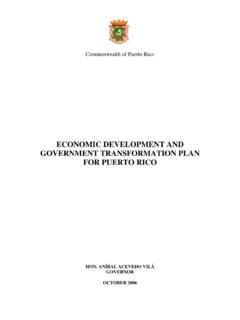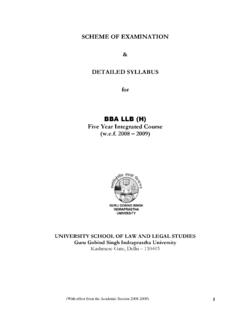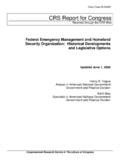Transcription of B.COM (3 YEARS COURSE RECOMMENDATION B.COM PART I
1 ( 3 years course ) RECOMMENDATION The clause 6 of the ordinance for Three YEARS degree COURSE be replaced by- Every candidate shall be examined in the following subjects: PART I A) GENERAL GROUP: RASHTRA GAVRAV One paper of 100 Marks. B) ACCOUNTS AND STATISTICS Two papers of 100 marks each Paper I- FINANCIAL ACCOUNTING Paper II- BUSINESS STATISTICS C) BUSINESS ADMINISTARTION Two papers of 100 marks each Paper I- PRINCIPLES OF MANAGEMENT Paper II- BUSINESS COMMUNICATION D) ECONOMIC AND FISCAL ADMINISTRATION Paper I- ECONOMIC THEORY Paper II- MONEY AND FINANCIAL SYSTEM PART II A) ACCOUNTS AND STATISTICS Two papers of 100 marks each Paper I- COST ACCOUNTING AND AUDITING Paper II- INCOME TAX B) BUSINESS ADMINISTRATION Two papers of 100 marks each Paper I- BUSINESS REGULATORY FRAMEWORK Paper II- COMPANY LAW C)
2 ECONOMIC AND FISCAL ADMINISTRATION Two papers of 100 marks each Paper I- BUSINESS ENVIRONMENT Paper II- FUNDAMENTALS OF ENTREPRENEURSHIP PART III A candidate will offer any two of the following three subjects: SUBJECT I ACCOUNTS AND STATISTICS This subject will consist of the following groups and a candidate can offer only one of the two groups: GROUP A Paper I- CORPORATE ACCOUNTING Paper II- FINANCIAL STATEMENT ANALYSIS Paper III- ADVANCED AUDITING OR GROUP B Paper I- FINANCIAL STATEMENT ANALYSIS Paper II- FUNDAMENTALS OF FINANCIAL MANAGEMENT Paper III- FINANCIAL MARKET OPERATIONS SUBJECT II BUSINESS ADMINISTRATION This subject will consist of the following groups and a candidate can offer only one of the three groups.
3 GROUP C Paper I- PRINCIPLES OF PERSONNEL MANAGEMENT Paper II- LABOUR LAWS IN INDIA Paper III- INDUSTRIAL RELATIONS OR GROUP- D Paper I- PRINCIPLES OF MAKETING Paper II- SALES PROMOTION AND ADVERTISING Paper III- MAKETING PRACTICES IN INDIA OR GROUP -E Paper I- INFORMATION TECHNOLOGY AND ITS APPLICATION IN BUSINESS Paper II- BUSINESS MATHEMATICS Paper III- ELEMENTS OF ACTUARIAL SCIENCE SUBJECT III ECONOMIC AND FISCAL ADMINISTRATION This subject will consist of the following groups and a candidate can offer only one of the three groups.
4 GROUP- F Paper I- INDIRECT TAXES Paper II- INDIAN BANKING SYSTEM Paper III- PUBLIC FINANCE OR GROUP -G Paper I FUNDAMENTALS OF INSURANCE Paper II- INSURANCE MANAGEMENT Paper III- LEGISLATIVE INSURANCE FRAMEWORK OR GROUP - H Paper I- INTERNATIONAL BUSINESS ENVIRONMENT Paper II- INDIAN FOREIGN TRADE AND POLICY Paper III- EXPORT IMPORT PROCEDURES AND DOCUMENTATION FIRST year ACCOUNTS AND STATISTICS GROUP PAPER I FINANCIAL ACCOUNTING COURSE INPUTS UNIT I Meaning and scope of Accounting: Need, Development and definition of accounting: Book-Keeping and accounting: Persons interested in accounting: Branches of accounting: Objectives of accounting.
5 Accounting Mechanism: Recording, classifying and summarizing of transactions, Ledger posting, Trial Balance. UNIT II Capital and Revenue : Classification of Income: Classification of expenditure: Classification of receipts. Final accounts: Manufacturing account: Trading account : Profit and loss account : Balance sheet: adjustment entries. Depreciation: Concept of depreciation: Causes of depreciation: Methods of depreciation: Provisions and Reserves. UNIT III Special Accounting Areas : Accounts related to: Royalty, packages, Branch Accounts: Dependent branch : Debtors system, stock and debtor system: Final accounts system: Wholesale branch: Independent branch: Foreign branch: Hire-purchase and installment purchase system: Insurance claims.
6 UNIT V Partnership Accounts: Essential characteristics of partnership: Final accounts: -Adjustments after closing the accounts: Fixed and fluctuating capital: Goodwill: Joint Life Policy: Change in profit sharing ratio. Reconstitution of a partnership firm-admission of a partner: Retirement of partner: Death of a partner: Amalgamation of partnership firms: Dissolution of a partnership firm. Modes of dissolution of a firm: Accounting entries: Insolvency of partners: Sale of firm to a company: Gradual realization of assets and piecemeal distribution. Suggested Readings 1. Anthony, and Reece, : Accounting Principles: Richard Irwin Inc.
7 2. Gupta, R. L. and Radhaswamy, M: Financial Accounting: Sultan Chand and sons, New Delhi 3. Monga Ahuja Girish, and Sehgal Ashok: Financial Accounting: Mayur Paper Back, Noida. 4. Shukla, Grewal and Gupta, : Advanced Accounts: S. Chand & Delhi 5. Compendium of statement and standards of Accounting: The Institute of Chartered Accountants of India, New Delhi. 6. Agarwala Agarwala : Higher Sciences of Accountancy: Kitab Mahal, Allahabad. PAPER II BUSINESS STATISTICS COURSE INPUTS UNIT I Introduction: Statistics as a subject: Descriptive Statistics-compared to inferential Statistics: Types of data: Summation operations: Rules of Sigma & operations.
8 UNIT II Analysis of Univariate Data: Construction of a frequency distribution: Concept of central tendency and dispersion-and their measures: Partition Values: Skewness and measures: UNIT III Regression and correlation. UNIT IV Index Number: Meaning, Types and uses: Methods of constructing price and quantity indices (simple and aggregate): Tests of adequacy: Chain-base index numbers: Base shifting, splicing and deflating: Problems in constructing index numbers: Consumer price index. UNIT V Analysis of Time Series: Causes of variations in time series data: Components of a time series: Decomposition-Additive and multiplicative models: Determination of trend-moving averages method and method of least squares (including linear, second degree, parabolic and exponential trend): UNIT VI Interpolation & Extrapolation.
9 Newton s Method , Binomial Expansion Method, Lagrange s Method. UNIT VII Indian Statistics- Main Statistical units at Central Level. Central Statistical Organization, National Sample Survey organization, Population Statistics- Census in India. Agricultural Statistics, Industrial statistics, Price Statistics, National Income statistics. Suggested Readings 1. Hooda, : Statistics for Business and Economics: Macmillan, New Delhi. 2. Ya-Lun Chou: Statistical Analysis with Business and Economic Applications, Holt: Rinehart & Winster, New York. 3. Lewin and Rubin: Statistics for Management: Prentice Hall of India, New Delhi. 4. Hoel & Jessen: basic Statistics fo Business and Economics: John Wiley and Sons, New York.
10 BUSINESS ADMINISTRATION GROUP PAPER I PRINCIPLES OF BUSINESS MANAGEMENT COURSE INPUTS UNIT I Introduction: Concept , Nature, Process and significance of management: Managerial roles (Mintzberg): An overview of functional areas of management: Development of management thought: Taylor, and Elten Mayo. UNIT II Planning: Concept, process and types. Decision making-concept and process: bounded rationality: Management by objectives: Corporate planning: Environment analysis and diagnosis: Strategy Formulation. UNIT III Organizing: Concept, nature, process and significance: Authority and Responsibility Relationships: Centralization and decentralization, Departmentation: Organization structure-forms and contingency factors.







